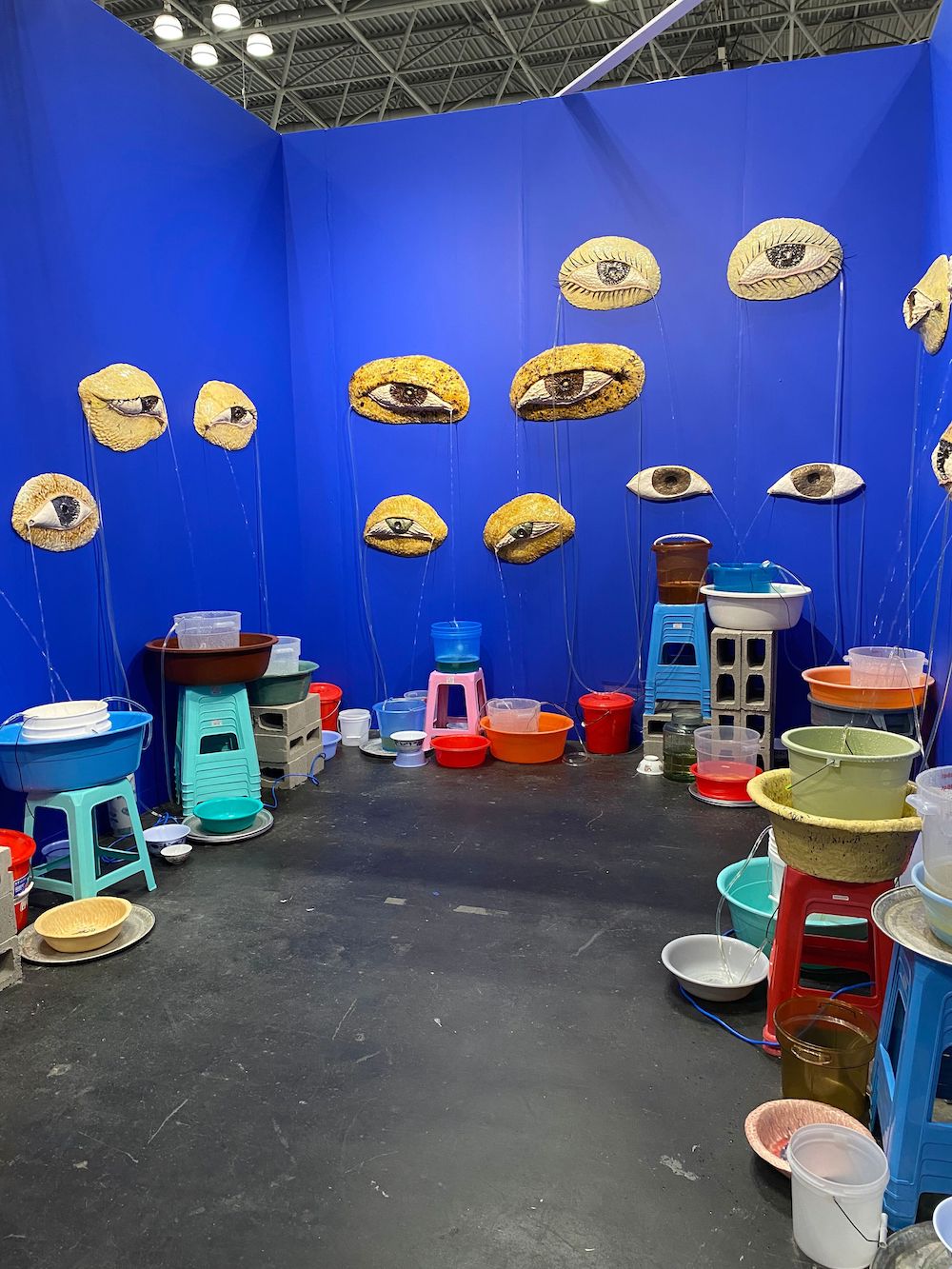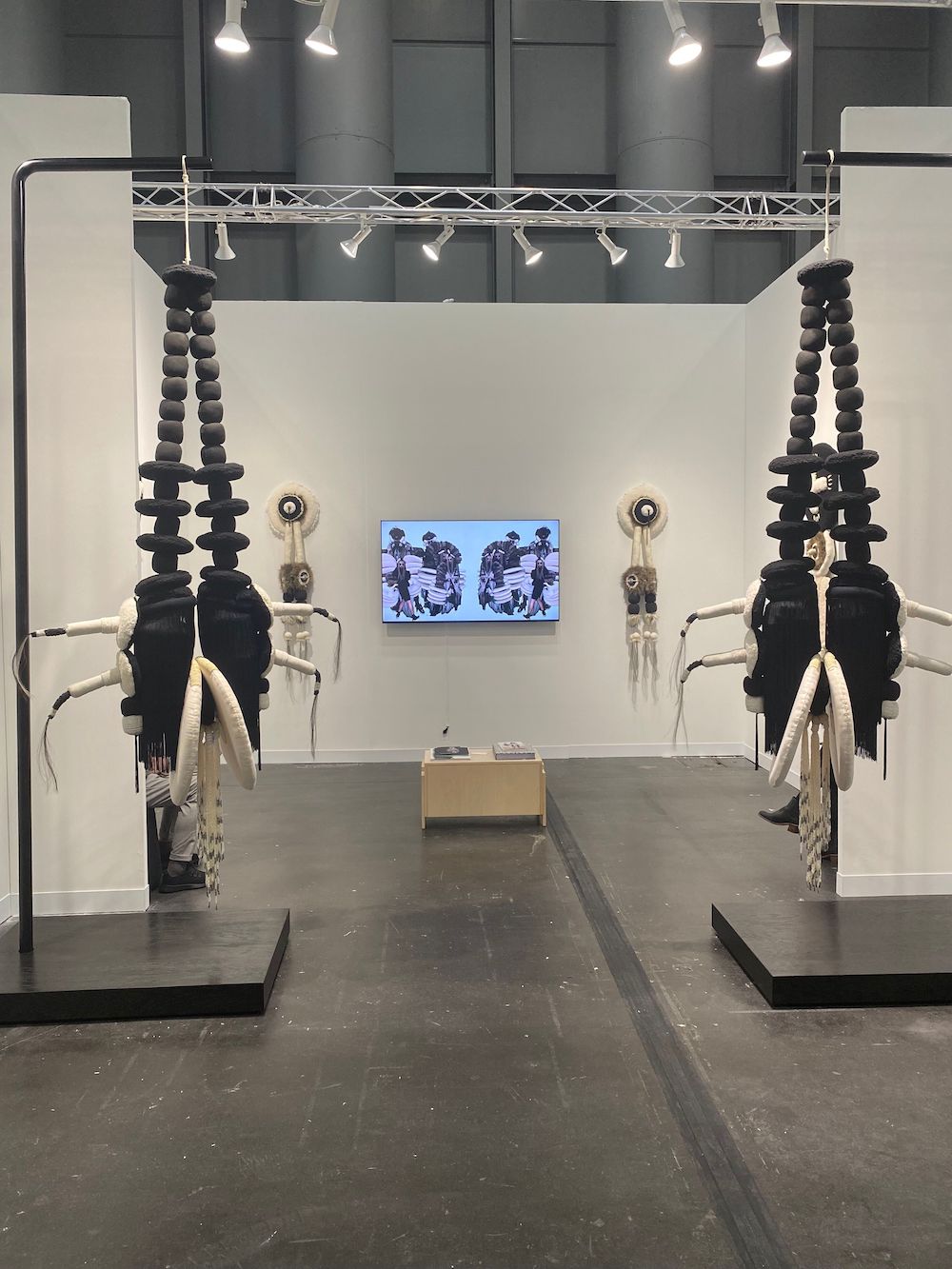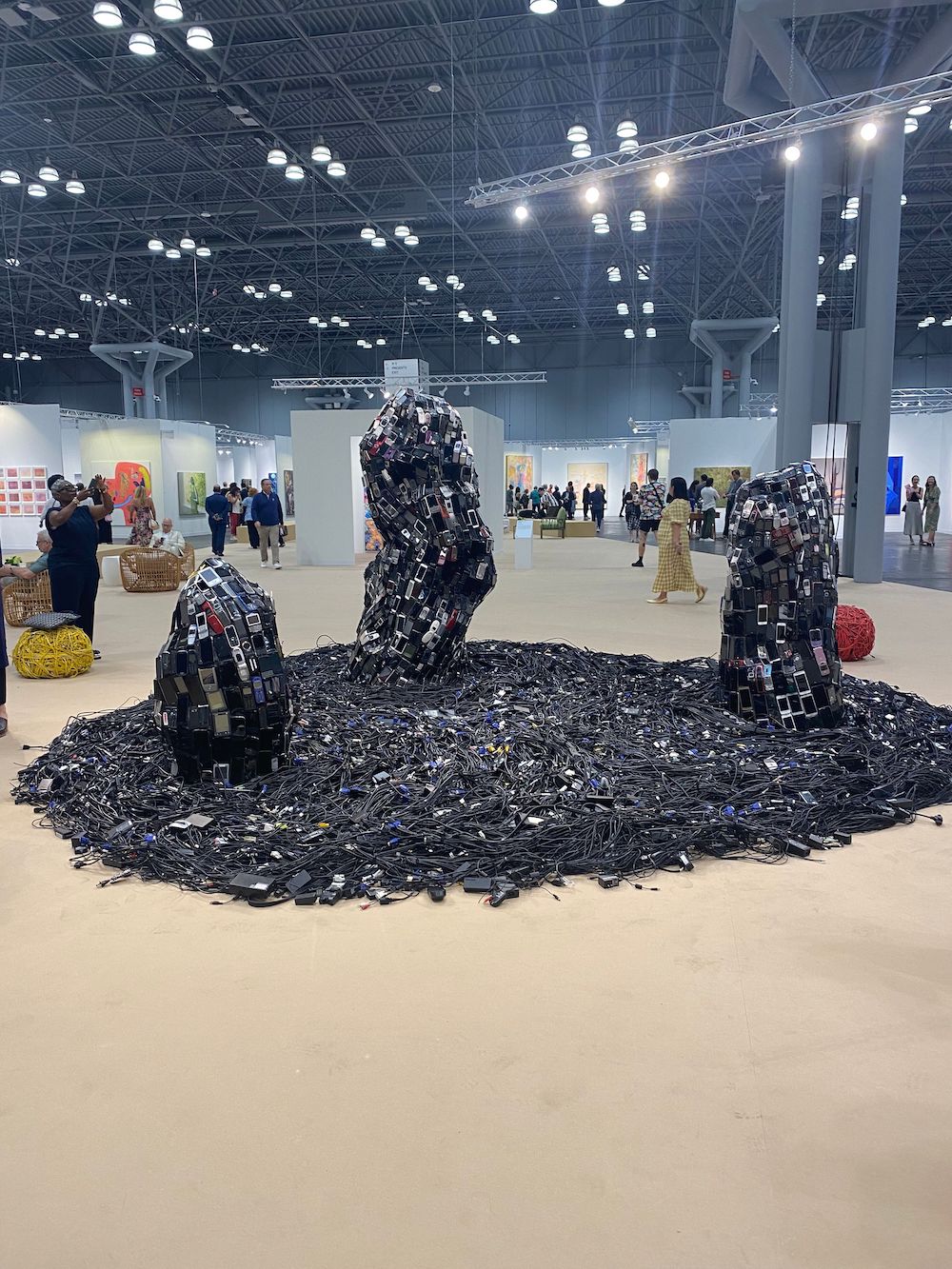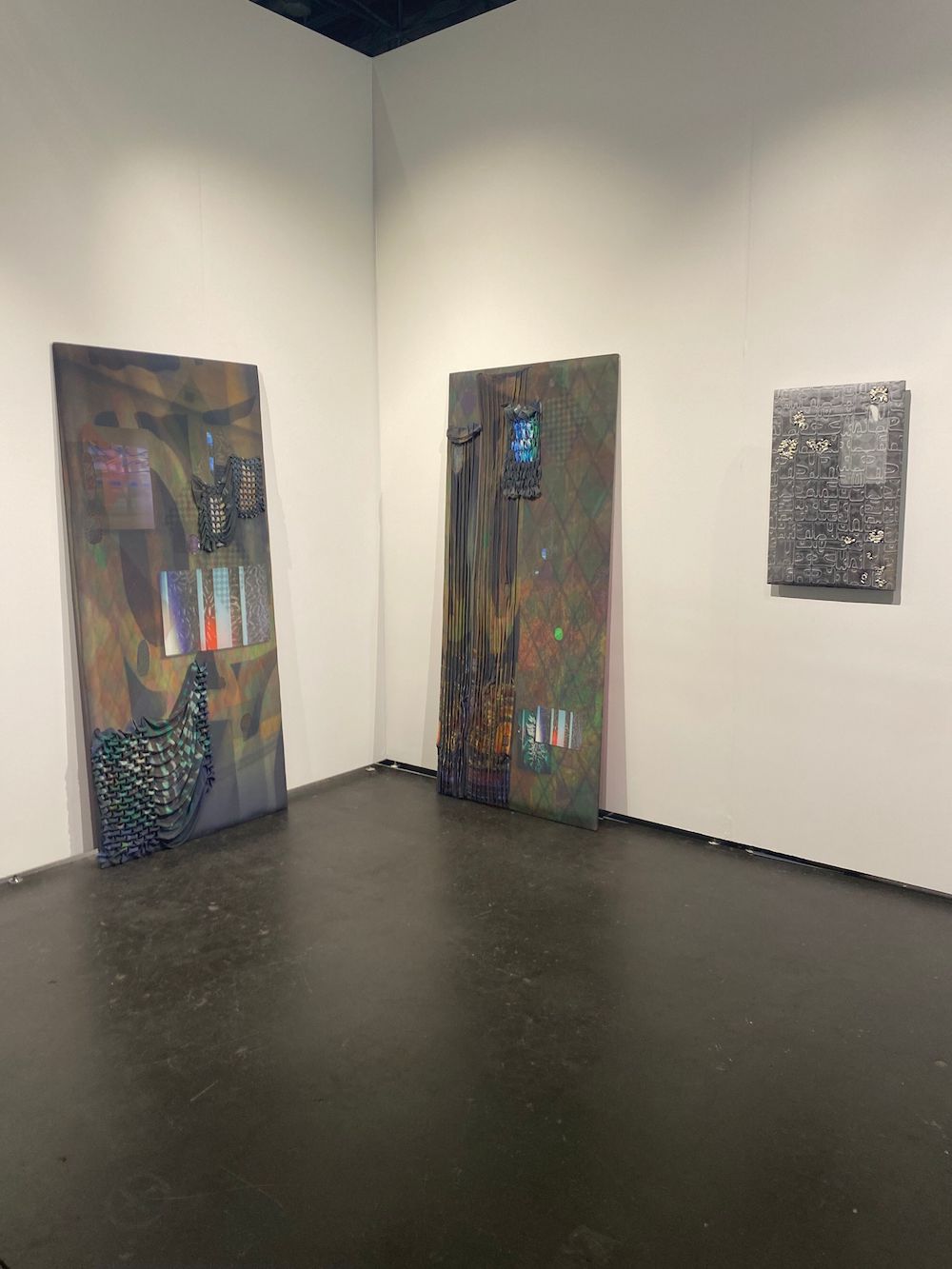With the summer flying by, the fall art season is already around the corner and New York is abuzz with art fairs, exhibitions, and events. As the cornerstone of the fall fairs, The Armory Show has returned to the Javits Center, bringing with it over 225 top galleries from around the world exhibiting the best and most promising artists. This year, the seasoned fair is sharing the sprawling convention center with PHOTOFAIRS, which is staging its inaugural New York edition. Thursday, the two events opened to press and VIPs who came in droves to shop, gossip, and see the art industry’s latest offerings.

Caleb Hahne Quintana in Anat Ebgi’s booth at The Armory Show (all photos by Annabel Keenan unless otherwise noted).
Greeting visitors to The Armory Show is a stunning painting by Caleb Hahne Quintana in Anat Ebgi’s booth. Featuring a boxer who has just been knocked out, the work is in a long, horizontal format that pulls the viewer in and places the athlete’s prostrate body at eye height. A testament to the artist’s skill, the boxer’s skin seems to glow red from within as if his blood is still pumping from the fight. Though he presumably lost the match, he appears far from defeated. Rather, the boxer represents evidence of the years of training that earned him a place in the ring.
In the Presents section featuring galleries under ten years old, Dinner Gallery is showcasing a solo booth of paintings and a Victorian Parlor installation by Phaan Howng. Exploring the connections between ecology and globalization, Howng’s dense fields of rare and exotic plants focus on expensive, non-native vegetation that rose to popularity during the Victorian Era. Narratives around exotic plants developed a sinister tone, describing killer vegetation like Devil Trees. Howng considers the relationship between plants, British imperialism, and the human impact on the natural world.

Cathy Lu’s work in Micki Meng’s booth at The Armory Show.
San Francisco-based gallery Micki Meng went for an immersive presentation with a solo booth by Cathy Lu. Entitled Peripheral Visions, the installation of ceramic eyes covers the walls and spills onto the floor, quite literally as water trickles out of each one into assemblages of buckets balanced underneath. Representing the artist’s eyes, as well as others of famous Asian women, the work reimagines Chinese garden waterfalls. It also provides a calming backdrop to the bustle of the fair.

Eric-Paul Riege’s work in Bockley Gallery’s booth at The Armory Show.
Across several booths is a strong presentation of Indigenous artists, including Gisela McDaniel’s (CHamoru) new figural paintings presented by Pilar Corrias. Examining the continued impact of colonization, McDaniel’s latest work centers on the climate activists and healers of the CHamoru people of Guam. Nearby, film documenting Eric-Paul Riege (Diné) performing in his wearable, mixed media sculptures illustrates another figural embodiment of Indigenous traditions in Bockley Gallery’s booth. Paying homage to generations of weavers in the artist’s family, the woven and assemblage pieces reflect stories from Diné culture and spirituality. Examples of these are on view alongside the video.
Using the language of abstraction to explore Indigenous histories and cultures is Jeffrey Gibson (Mississippi Choctaw/Cherokee), whose colorful, geometric prints showcasing the influence of Indigenous design are on view with Tandem Press. The artist, who was recently selected to represent the United States at the 2024 Venice Biennale, has several works on view across the fair (really, I lost track of how many exhibitors brought something by the artist), including his highly acclaimed beaded sculptures. Also exploring abstraction is Sara Flores (Shipibo-Conibo) who uses pigments of native Peruvian flora in drawings with meticulous, intricate patterns from Kené traditions that translates medicinally-induced visions into geometric designs, on view in CLEARING’s booth.

Jean Shin in the Platform section of The Armory Show.
Taking advantage of the sprawling, open space of the Javits Center, The Armory has dedicated a section to large-scale installations entitled Platform. Curated by Eva Respini, the Vancouver Art Gallery’s newly appointed Deputy Director and Director of Curatorial Programs, this year’s section is centered on the theme of “Rewriting Histories” and includes twelve artists whose work challenges or expands artistic, cultural, and historical canons. A highlight is Jean Shin’s Huddled Masses (2020). From afar, the piece resembles a dark landscape of geode-encrusted boulders in a field of black, glittering waves. Recalling Zen rock gardens, the installation is meditative and visually captivating. Upon closer inspection, the materials are revealed to be hundreds of cell phones and computer cables amassed like an archive of modern technology and a portrait of consumer culture and electronic waste.
Outside of the convention center, The Armory team is staging public installations across the city to engage the local community and general public. For the second time, they’ve partnered with the US Tennis Association to present three large-scale sculptures at the US Open. A highlight is Allen-Golder Carpenter’s concrete sculpture of stacked casts of Nike “Air Force” soles presented by New York-based No Gallery. Entitled Foundation 6 (2023), the work reflects on the importance of the shoe in Black culture, so much so that when Nike planned to discontinue the style, members of the Black community wrote letters that led to its revival.

Eric Hart Jr.’s work in For Freedoms’ booth at PHOTOFAIRS.
While spending several hours in the Javits Center is daunting (and not advisable), PHOTOFAIRS’ decision to launch their inaugural New York edition in the same building was undeniably convenient. Dedicated to new media, digital art, and photo-based artwork, PHOTOFAIRS offers a refreshing counterpoint to the relatively photo-free Armory Show.
A highlight of PHOTOFAIRS is For Freedoms’ presentation of work by Da’Shaunae Marisa, Emanuel Hahn, McKayla Chandler, Eric Hart Jr., and Maya Mansour, who are all inaugural For Freedoms Fellows. In line with the organization’s mission of promoting civic engagement, direct action, and discourse, the artists on view engage with various issues facing people of color and aim to make the fine art sector more equitable. Included are stunning black-and-white portraits from Hart Jr.’s first ever monograph, When I Think About Power, which was recently published and explores structures of power in relation to the queer Black experience.

Tiffany Smith in TERN Gallery’s booth at PHOTOFAIRS.
Providing an interactive element to the fair, TERN Gallery is presenting a photo booth based on work by Tiffany Smith from her Throned series. With props including a crystal-embellished wicker throne and custom wallpaper featuring botanical drawings native to the Caribbean, the installation invites viewers to activate the empowering and meditative space. They can take photographs of themselves and participate in sittings with Smith, who will be on site Saturday between 3 and 5 PM.
Nearby, Robert Mann Gallery impressed with a site-specific work by the artist duo Sayler/Morris (Susannah Sayler and Edward Morris) that addresses critical issues of species extinction. Focusing on the passenger pigeon, which disappeared a century ago despite having had a massive population. Historical accounts of the large flocks emphasized the scale of the population, reporting that the skies would darken for hours while the birds flew by. At once haunting and mesmerizing, the work is a reminder of the fragility of all species and the continued threat that environmental crises pose.

Emma Safir in Baxter St’s booth at PHOTOFAIRS.
Baxter St at the Camera Club of New York, a program partner of the fair and the oldest artist-run, lens-based non-profit in New York, is presenting work by Emma Safir and facilitating two talks that expand contemporary perspectives on the materiality, display, and function of photography. Safir’s work, modern prometheus III, operates as screen simulations that address labor systems and hierarchies, in particular in relation to gender and digitization. Together, the presentation illustrates Baxter St’s pivotal role in pushing the boundaries of lens-based art.

Ed Ruscha, OOF, 1962.
While art fairs provide the best opportunity to see a high volume of artworks before they’re (very likely) stowed away in private collections, the institutional shows coinciding with the fairs are often some of the strongest of the year. Leading the pack is “ED RUSCHA/NOW THEN”, a major retrospective of the artist at the Museum of Modern Art (and traveling to LACMA next year), his first ever solo show at the museum. Spanning nearly seven decades and featuring over 200 works, the exhibition is the most comprehensive survey of the legendary artist’s prolific career.
In addition to their PHOTOFAIRS booth, For Freedoms is presenting a thought-provoking exhibition Listen Until You Hear at Fotografiska. Featuring artists who explore “visual listening,” the show inspires viewers to connect with the works on view on a more profound level, considering how their entire body responds to the exhibition and to other individuals and groups.
On the gallery front, Mexico City-based JO-HS is hosting a Tribeca pop up show of new eerie, yet captivating paintings by Floria González in “Mixtape.” Inspired by the artist’s experiences with synesthesia and illustrating her interest in blending cultural allusions with an imagined future, the richly layered works are at once familiar and foreign as recognizable imagery fades into strange, even haunting scenes. In one work, a man walks his dog in front of a sinister castle as the dense, blue forest encloses in on the pair. A closer look reveals that both man and dog are in fact robots, perhaps offering a glimpse at a potential future.
Another standout gallery exhibition is Zoë Buckman‘s solo show of mixed media narrative portraits on vintage textiles in Tended at Lyles & King. Building on the artist’s practice of exploring her life and friendships, as well as collective traumas and shared experiences, the show features a new body of work centered on the healing power of personal relationships. Buckman highlights in particular female and genderqueer friendships, and how these have helped work through some of the major challenges in recent years, from Covid-19 to the reversal of Roe v. Wade.
While the current heat wave belies the imminent fall season, Armory Week undoubtedly marks the start of fall for the art world. With a mix of shock and reluctance, the summer lull is over and there is only one way to describe the feeling. In the words of Ed Ruscha, OOF.


